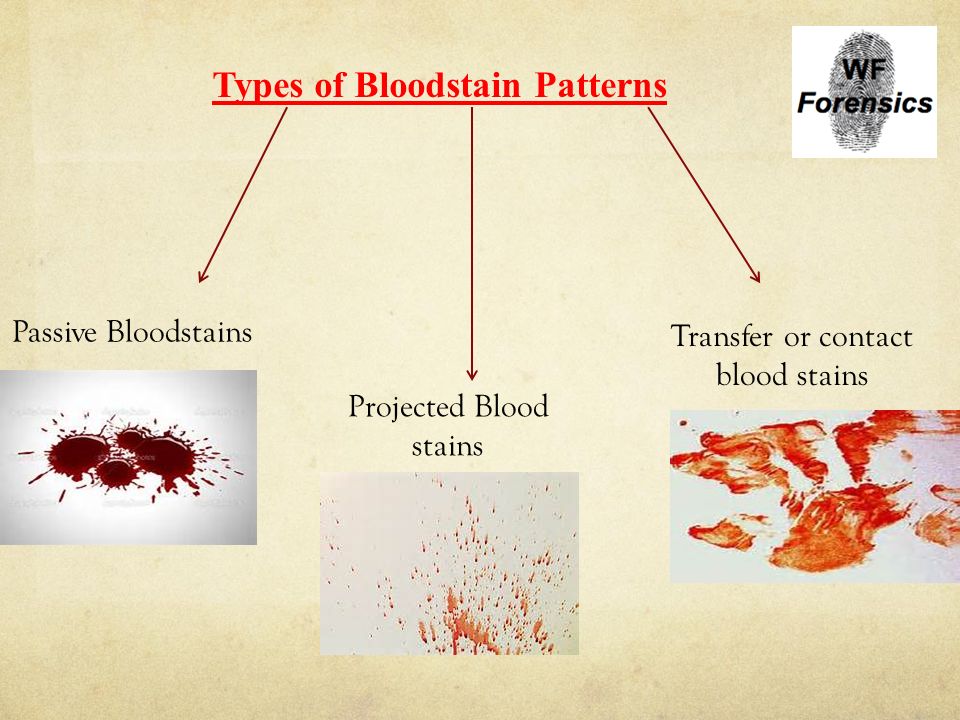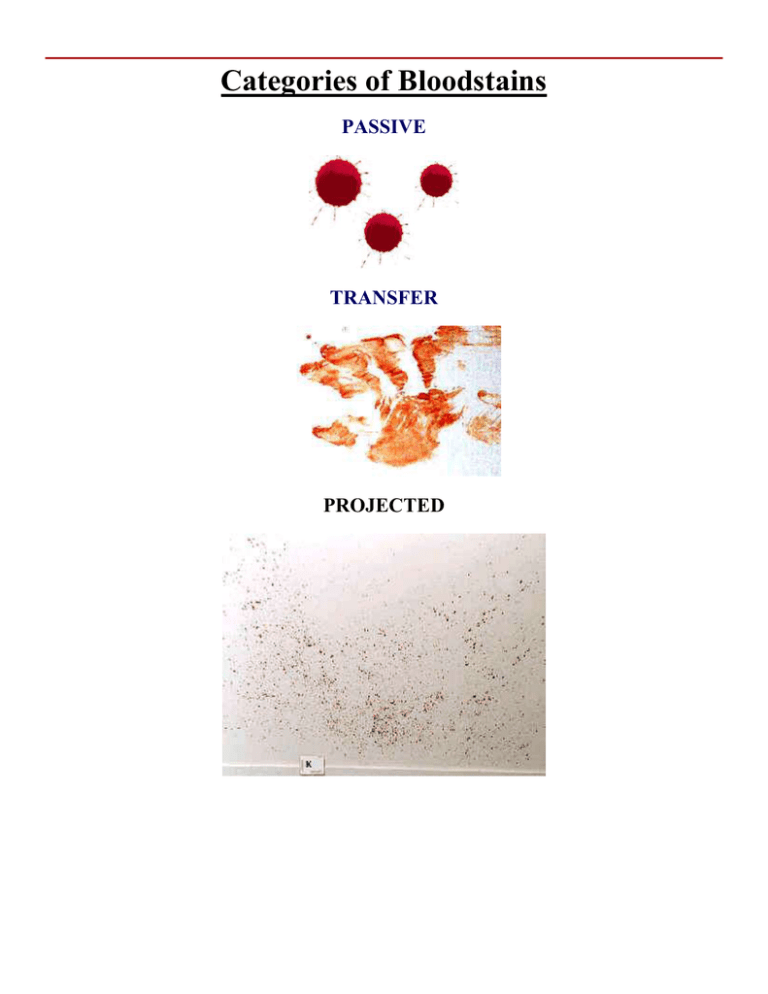6 wipe bloodstain patterns. Identify the mechanisms by which blood spatter patterns are created.

Unit 7 Blood And Blood Spatter Ppt Video Online Download
The directional angles of the individual stains when considered together will show this radiating effect.

. Projected outward in a radiating pattern. Common types of blood spatter and transfer found at crime scenes. Bloodstain Pattern Analysis BPA is the field of forensic science that consists of the study and analysis of bloodstains at a known or suspected crime scene with the purpose of drawing conclusions about the nature timing and other details of the crime.
What are the 4 types of passive bloodstains and how do they differ. Up to 24 cash back Projected bloodstains happen when some form of energy has been transferred to a blood source such as a human victim. Design a technique to simulate and model various blood-spatter patterns.
In the context of crime scene investigation bloodstain pattern analysis is the process of analyzing the location and shape of all the blood at a crime scene to determine the sequence of events that caused the bloodstains. Recognize and describe different blood-spatter patterns. Blood is in a liquid state when inside the body and when it exits the body.
And with new computerized methods of analysis coming online there may be more consistency and reliability in the future. Prepare expert witness testimony analyzing a blood-spatter pattern. Blood is one of the most frequently encountered types of physical evidence.
Reviewed by Emily Henderson BSc. Though bloodstain pattern analysis BPA can be a subjective area of study at times and often reliant on the experience of the investigator the idea that blood will obey certain laws of. That being said a well-trained and seasoned analyst can provide key information that leads to arrest and conviction.
Passive stains include drops flows and pools and typically result from gravity acting on an injured body. For example powerfully projected sprays of blood would suggest that the attack was fierce and was meant to kill the victim. To understand how analysts interpret bloodstains one must first understand the basic properties of blood.
There are seven bloodstain categories. Blood contains both liquid plasma and serum and solids red blood cells white blood cells platelets and proteins. Different types of Projected bloodstains are.
Often found at the scenes of violent crimes the analysis of bloodstains can provide vital clues as to the occurrence of events. Sine i Width ab Length bc Inverse Sine ASIN i Angle of Impact. Our knowledge is extensive and we perform our own tests to reproduce events.
Drips which result from blood dripping onto blood can fall from a bleeding nose or wound or a motionless bloodied weapon or object. Name two types of bloodstain patterns that require confirmation by autopsy findings. Use patterns to reconstruct events based upon bloodstain patterns.
Up to 24 cash back At the end of this activity you will be able to. Include in the testimony a possible scenario of how that blood-spatter pattern resulted as well. Explain how the following types of blood spatter may occur.
Subdivided drops drip patterns pools clots c. IFS experts have investigated hundreds of cases where bloodstains tell the story. Crime scene investigation CSI technicians make a series of different measurements on the bloodstains at a.
However further research needs to be conducted to provide a solid method of computerized bloodstain pattern analysis that can be utilized for all types of stains. Introduction Becausebloodbehavesaccordingtocertainscientificprinciplestrained bloodstainpatternanalystscanexaminetheblood. One pattern of slow-moving blood called drips occurs after an injury and has a relatively large footprint of 016 inches 4 millimeters or more.
What qualifies as a projected bloodstain. A blood droplet striking a surface such as the floor can be thought of as a RIGHT TRIANGLE. Single drop Series of drops Flow patterns Pooling 8.
Principles of Bloodstain Pattern Analysis. And 7 transfer bloodstains. Nature of the force used to cause the bloodshed.
Investigation of death and violent crimes. Passive stains transfer stains and projected or impact stains. Low-impact velocity drops are easily characterized by round smooth edges and are produced by gravity.
Formed from the force of gravity acting alone. In general bloodstain pattern analysis BPA refers to the collection and subsequent forensic analysis investigation of the size. Wipe Pattern which is created when an object moves through an existing stain and alters or removes it appearance.
Create and interpret transfer patterns. Different types of Transfer bloodstains are. As a result the two known measurements from the crime scene the length and width of the bloodstain can be used in a mathematical formula.
It is used mostly to study homicide or other violent crimes in which blood is present and can help in crime scene. Spatters show progressive change in individual stain shape further out in pattern they are Blood subjected to force will radiate outwardly from the blood source. Describe the directly propor tional relationship between stain diameter and dropping height.
Sequencing of multiple bloodshed events. Low medium and high impact spatters cast-off arterial spurting expiratory blood 9. Bloodstain patterns reveal not who but what with regard to the circumstances of.
Bloodstain pattern analysis seeks to define the facts surrounding an investigation by the use of the physical nature of bloodstains. The object used to cause the bloodshed. 6Interpretation of contact or transfer patterns.
Bloodstain Pattern Analysis is the study of the size shape and location of bloodstains in order to provide an interpretation of the physical events which gave rise to their origin. Transfer stains result from objects coming into contact with existing bloodstains and leaving wipes swipes or pattern. A moving object produces whats known as a cast-off pattern.
Explain why an assailant might not have any bloodstains on his or her person or clothing after participating in a beating death. Describe how the surface texture of an object affects the shape of individual bloodstains. The circumstances and nature of violent crimes frequently produce a variety of bloodstains.
Oozing or gushes from the body dripping finger or arm drops from a knife. Bloodstain pattern analysis is the use of the size shape and distribution patterns of the bloodstains found at a crime scene to reconstruct the bloodshed events. Wet bloody surface comes in.
5 arterial gush or spurt bloodstains. When properly documented bloodstain patterns found at the crime scene or on a particular persons clothing can be used to. List the components of human blood.
Up to 24 cash back Bloodstains are classified into three basic types. Lets start our investigation into this topic with the basics of bloodstain pattern analysis. By Benedette Cuffari MSc.

Forensic Characterization Of Bloodstains Ppt Video Online Download

Categories Of Different Bloodstain Patterns Categories Of Different Download Scientific Diagram

0 Comments